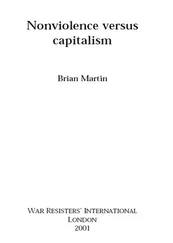In the case of Czechoslovakia, the liberalisation of communist rule during 1968 was a mass-based process that challenged the normal control — including control of the media — by those following the Soviet line. The Czechoslovak radio system was temporarily a powerful force for the nonviolent resisters, in a situation where there was a high intensity of face-to-face dialogue, both among the population and between Czechoslovaks and invading soldiers. It is also worth noting that capture of the radio network by the Soviet army decisively ended the active phase of the resistance.
In East Germany in 1989, the Communist Party retained control over the local mass media. West German radio and television provided a window into alternative views, including news of events in East Germany itself, that fed into the protest by East Germans, which itself was based on a commonality of experience.
These cases suggest that one-directional media can sometimes be useful to a nonviolent movement against repression, but only under certain conditions. There must be a strong underlying unity of purpose, itself the outgrowth of common experience and dialogue. Also, the one-directional media are used in a challenging mode, against an even more pervasive or powerful system of persuasion or control.
This conclusion can be summarised by saying that one-directional media are selectively useful for oppression and network media are selectively useful for resistance to oppression. [37] . In the appendix, this terminology is explained in the context of theories of technology.
Technologies are not neutral, but nor are they tied to certain uses only. Technologies are stamped by the social groups and goals involved in their creation and application. But the uses of technologies are not fixed by their creators: users can adapt them to some extent. For example, the US military originally set up the computer network that later evolved into the Internet which has become one of the most participatory media available.
Generally speaking, the greater the opportunity for users to choose, use and modify the technology, the greater its potential for fostering popular participation and the more likely it is to be useful for nonviolent action against repression. Interactive network media can aid nonviolent action most of all when they are generally accessible, easy to use, difficult for dominators to control, and when they encourage widespread development of appropriate skills.
For a society to engage effectively in a struggle, whether violent or nonviolent, it must be able to maintain the necessities of life, such as food and shelter. In industrialised societies, many important systems, including agriculture, energy, water, transport and housing, have become highly vulnerable to either military attack or sabotage.
Take the electricity system, for example: a few bombs or just some calculated breaches of proper procedures could put large generating plants and transmission stations out of action. If computer programs that ensure a balance between electricity supply and demand were intentionally altered, a system breakdown could easily be triggered.
Fuel supplies are only somewhat more secure. Oil refineries are perhaps the most vulnerable point: a few knowledgable workers could put them out of commission. Oil pipelines and ocean tankers are also easy targets for determined saboteurs. [1] . On energy vulnerability see Wilson Clark and Jake Page, Energy, Vulnerability, and War: Alternatives for America . New York: Norton, 1981; Amory B. Lovins and L. Hunter Lovins, Brittle Power: Energy Strategy for National Security . Boston: Brick House, 1982; James L. Plummer, ed., Energy Vulnerability . Cambridge, MA: Ballinger, 1982.
Water supplies for many cities are quite vulnerable to attack. All it would take is destruction of a few large dams or poisoning of the water supply.
Food supplies are far more vulnerable to disruption than just a century ago. Production is now heavily dependent on fertilisers and pesticides; factories producing these could be put out of action. Biologically sophisticated saboteurs might be able to spread pests and diseases to major crop areas. Few people still live on the land; city populations depend on shipment of large quantities of food from agricultural areas.
Then there is the transport system. Disruption of electricity and fuel supplies would be devastating. Another approach would be tampering with transport computer systems. City traffic would be reduced to a crawl if traffic lights were out of action, and air traffic would become much more risky if automated systems were disrupted. [2] . See Colin Kearton and Brian Martin, “Technological vulnerability: a neglected area in policy-making”, Prometheus , vol. 7, no. 1, June 1989, pp. 49-60; Peter G. Neumann, Computer-Related Risks (New York: ACM Press, 1995).
For a military system, these vulnerabilities mean that an effective defence must prevent the enemy from entering the country’s territory. A single bomber or missile can cause enormous havoc. The vulnerability of modern technological systems thus is a justification for so-called “forward defence,” namely powerful offensive capacities, including nuclear weapons as deterrents. Vulnerability is also a justification for tight internal security, to guard crucial facilities from saboteurs and to keep information about both military and civilian facilities secret. Thus, vulnerable technological systems play a role in promoting two of the worst features of the warfare society: offensive military capacity and internal repression. [3] . Brian Martin, “Technological vulnerability,” Technology in Society, Vol. 12, No. 4, 1996, pp. 511-523.
These considerations in themselves should be enough to motivate investigation into less vulnerable systems. In the case of nonviolent struggle they become overwhelming. Without military forces, there is nothing to physically stop enemy troops from entering the community, taking over key facilities such as power stations, cutting off supplies or even destroying the facilities. Given this possibility, developing resilient systems is essential.
Actually, the problem of survival is seldom a telling factor in major struggles. In most wars, even the most ferocious, no attempt has been made to starve the enemy population to death. Nevertheless, there are some instructive examples where survival has played a key role.
After Iraqi troops invaded Kuwait in August 1990, international sanctions were applied to Iraq, preventing most imports and exports. Even after the defeat of Iraq military forces by the US-led coalition in March 1991, the blockade was continued. The bombing of Iraq in early 1991 destroyed much of the country’s infrastructure, including water purification plants, electricity generating plants and industry. The continuation of the blockade — which also prevented import of food and medicines, in contravention of international humanitarian agreements — has led to enormous suffering and increased mortality and perhaps a million or more deaths as a result. [4] . Geoff Simons, The Scourging of Iraq: Sanctions, Law and Natural Justice (Basingstoke: Macmillan, 1998, 2nd ed.); Nikki van der Gaag (ed.), “Iraq: What United Nations sanctions have done” (theme issue), New Internationalist, No. 316, September 1999.
This example illustrates the high vulnerability of a westernised society.
Although economic “sanctions” — restraints on trade — are commonly seen as a nonmilitary alternative to war, they rely on armed force for implementation and definitely cannot be considered a method of nonviolent action. Sanctions often are ineffective or counterproductive. [5] . David Cortright and George A. Lopez (eds.), Economic Sanctions: Panacea or Peacemaking in a Post-Cold War World? (Boulder: Westview Press, 1995).
Читать дальше












